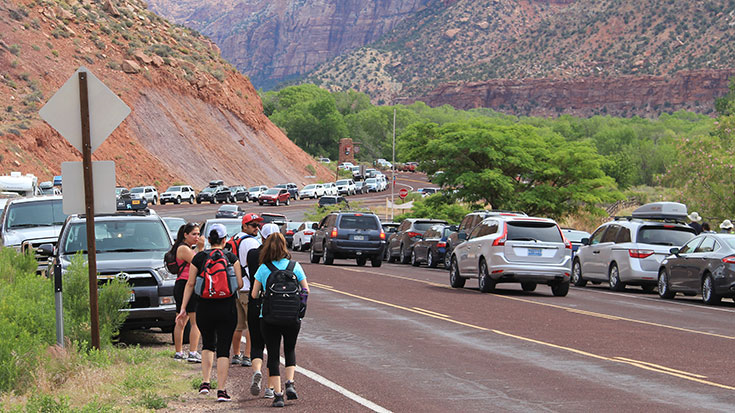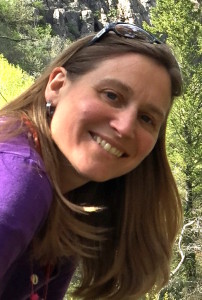By Cory MacNulty for EDRblog.org.
Just under 12 million people visited Utah’s 13 national park sites in 2015. Park enthusiasts are flocking to these iconic landscapes to scramble up Angels Landing at Zion National Park, contemplate the Milky Way galaxy and dark, starry night skies at Bryce Canyon National Park, and to experience an awe inspiring sunset at Delicate Arch in Arches National Park. As visitation to Utah’s national parks explodes, drawing record numbers of visitors from around the world, park managers and the neighboring communities must work together to find balance and creative solutions to protect these wonderful places for future generations.

In many ways the uptick in visitation signals a wild success for statewide and local tourism marketing campaigns. Since the State of Utah launched its “Mighty 5” marketing campaign in 2013, encouraging national and international visitors to experience the state’s five national parks – Zion, Bryce Canyon, Capitol Reef, Canyonlands, and Arches—visitation has increased by 14%. By many measures, that campaign has been a huge success, generating over $844 million in visitor spending in 2015, benefiting rural gateway communities.
But when does the success become too much? In 2015, 3.6 million visitors flooded into Zion National Park alone and visitation in this year, the centennial of the National Park Service (NPS), is expected to dwarf last year’s numbers. Visitors on many days now encounter lines to enter the park, lines to ride the mandatory shuttle and lines of tourists walking in each other’s footsteps into Zion Narrows and up to Angels Landing. The additional cars and people are pushing park staff and infrastructure (sewage systems, parking, shuttle system) beyond their capacity, polluting the air, consuming limited water resources, leaving mountains of waste and trampling sensitive desert ecosystems.
This tension between resource preservation and providing access for visitors is not new to the NPS but stems directly from its dual mission laid out in the Organic act 100 years ago – “to conserve the scenery, and natural and historic objects and wild life therein and to provide for the enjoyment of the same . . . as will leave them unimpaired for the enjoyment of future generations.” But are we at a tipping point at our most popular national parks where not only the natural and cultural resources are impacted, but also the visitor experience itself?
Opportunities for solitude and quiet to deeply connect with wild places, and in turn ourselves, are becoming harder to find in our national parks. Even more disturbing, are reports from park rangers that visitor behavior and expectations are shifting as people become increasingly disconnected from natural quiet and open spaces. Graffiti and intentional resource damage is on the rise as is a disregard for rangers and fellow travelers. What responsibility does the NPS have in preserving and sharing these experiences and how do they balance that with resource protection and open access to the public?
To be notified when new EDR blog articles are posted, please sign up for our listserve »
Zion National Park has started to explore these very questions, and to seek an appropriate balance and identify creative solutions by reaching out first to key park staff, partners and community leaders through a collaboration clinic held last August. Then last month NPS asked the public for their input through a series of listening sessions held in nearby communities and online. These are just the beginning steps to develop a Visitor Use Management Plan that will assess visitor impacts and identify solutions to minimize those impacts and protect the visitor experience in the park.
But just as national park resources need to be protected within a broader landscape, solutions for visitor use challenges must be created and integrated within the broader social landscape through collaboration with neighboring communities. For each decision made in a gateway community – to widen a road, add a hotel, or increase parking – can add to the flow of visitors into the park, and each decision in the park – to change a fee, require a permit, or add a timed entry system – can change the daily life and dynamics of that gateway community. And how communities market and promote the national park experience can help shape visitor behavior and expectations.
Springdale, the quintessential gateway community that works hand-in-hand successfully with Zion National Park, must also strive to find their own balance between economic growth and preserving their community’s quality of life. As a small, rural community reliant on a booming tourism economy, Springdale faces its own challenges in accommodating record numbers of visitors for longer periods of time each year including overtaxed infrastructure, traffic congestion, cost of living and affordable housing. The mayor, town council and residents are proactively working to preserve the quaint, small town feel that defines the visitor experience to their community in the face of growing visitation to Zion National Park.
An excellent example of how Zion National Park and Springdale have already worked collaboratively to eliminate parking congestion in Zion Canyon and reduce traffic congestion in town is the shuttle system that visitors are required to ride into the canyon during the park’s busiest season. Rather than the shuttle starting in the park, there are stops all the way through Springdale so visitors can leave their cars south of town or at their hotels. While the shuttle has been successful in reducing some issues created by too many cars, more creative, collaborative solutions like this are needed as visitation continues to grow and the number of people as well as cars overwhelm the current system.
Efforts to achieve a delicate balance in the face of rising national park visitation are playing out across Utah, at Arches National Park and Moab, and Capitol Reef and Torrey, and at national parks across the country. Open dialogue and collaboration between national park managers and gateway community leaders is critical to identifying and implementing creative solutions that preserve our national park resources and experiences generation after generation while achieving sustainable tourism economies and quality of life in gateway communities.
Recognizing the significance of the two-way relationship between parks and gateway communities, National Parks Conservation Association (NPCA) is committed to helping create and participate in collaborative forums that build bridges among national parks, other public lands and neighboring communities. In November 2013, NPCA, along with a dedicated team of community leaders, co-hosted the first ever Utah Gateway Community Forum that drew over 100 participants from 25 communities and public lands across the state. The forum provided participants the opportunity to network, identify priority challenges (such as environmental integrity, land access and community quality of life), share creative solutions, and begin a process of supporting one another as Utah began to more proactively develop its communities as gateways.
Through the Gateway Community Forum initiative, as well as our work on collaborative land management efforts such as the Bureau of Land Management Master Lease Planning process for oil and gas development, we discovered:
- More people are seeking forums to build bridges and work together to solve public land challenges than the media and elected officials regularly portray.
- Understanding each other’s perspectives is critical to finding common ground.
- Open dialogue is fundamental for understanding each other’s goals and limitations.
- Be ready to meet people where they are…not where you want them to be.
Additional resources:
http://www.cbsnews.com/news/on-the-trail-the-big-crush/
http://fivethirtyeight.com/features/the-national-parks-have-never-been-more-popular/
Cory MacNulty is a Utah Senior Program Manager for National Parks Conservation Association where she works to protect and promote the natural and cultural resources of the thirteen national parks in Utah. She specializes in stakeholder collaboration, particularly with gateway communities, to identify opportunities and creative solutions to threats facing our parks.

 http://www.thespectrum.com/story/opinion/2016/01/01/national-park-service-faces-tall-task-zion/78175470/
http://www.thespectrum.com/story/opinion/2016/01/01/national-park-service-faces-tall-task-zion/78175470/